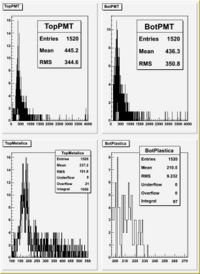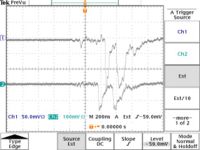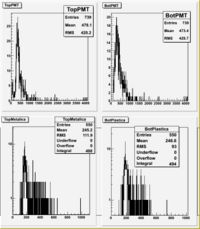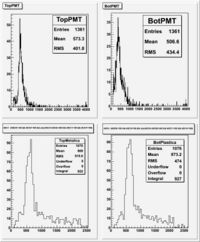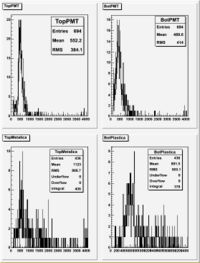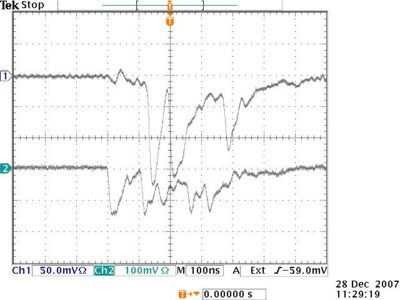Difference between revisions of "MiniPrototype CosmicRuns"
| Line 164: | Line 164: | ||
#The first was that our top scintillator paddle was too big. Two scintillator paddles of the same size (3" x 20" x 1/2") were used at first. The Top paddle was placed such that only 4cm were covering the endplat of the chamber known as Metalica. The Bottom scintillator was placed on edge ( cosmic rays traveling through both drift chambers would pass through 3" of scintillator) and "perpendicular" to the top scinitllator. | #The first was that our top scintillator paddle was too big. Two scintillator paddles of the same size (3" x 20" x 1/2") were used at first. The Top paddle was placed such that only 4cm were covering the endplat of the chamber known as Metalica. The Bottom scintillator was placed on edge ( cosmic rays traveling through both drift chambers would pass through 3" of scintillator) and "perpendicular" to the top scinitllator. | ||
| − | |||
#I believe the second problem was running the drift chamber at too high of a voltage. At 1500 Volts we would see signals on the scope like the one below when using the 90/10 AR/CO2 mixture. Using the 75/25 gas mixture would allow us to increase the HV to 1600 Volts before seeing similar signals. Perhaps there is an upper limit in voltage where the quenching gas is less effective causing such signals. | #I believe the second problem was running the drift chamber at too high of a voltage. At 1500 Volts we would see signals on the scope like the one below when using the 90/10 AR/CO2 mixture. Using the 75/25 gas mixture would allow us to increase the HV to 1600 Volts before seeing similar signals. Perhaps there is an upper limit in voltage where the quenching gas is less effective causing such signals. | ||
Revision as of 16:28, 2 January 2008
Cosmic Coincidences
setup
Setup a cosmic coincidence experiment with two crossed scintillators that have the proto-type drift chambers sandwhiched between them.
Built 4 100 ns long delay cables. 2 for the PMTs and one for sense wire 7 on each of the drift chambers.
The top PMT is in channel 7 of the QDC and channel 16 of the scaler.
The Bottom PMT is on channel 8 of the QDC and channel 7 of the scaler.
Coincidence counts are recorded in channel 2 of the scaler.
Runs
Drift Chamber is off
Run 182: Ran with coincidence module in "OR" mode so if either paddle triggered the ADC was read out
Run 183: Switched coincidence module to "AND" mode and ran overnight.
12/23/07
Drift Chamber turned on with 90/10 ArCO2 and the voltages below
| HV settings | ||
| Wire | Volts | current (A) |
| Sense | 1500 | 19 |
| Field | -800 | 19 |
| Guard | 800 | 0 |
Run 204: Scope was plugged into DC output (split signal)
12/24/07
Run 206: Unplugged scope and started this run
Drift Chamber turned on with 90/10 ArCO2 and the voltages below
| HV settings | ||
| Wire | Volts | current (A) |
| Sense | 1500 | 19 |
| Field | -800 | 19 |
| Guard | 800 | 0 |
I had a bad ribbon cable on plastica. Ignore the results for Plastica. It was just a good pedestal measurement.
It looks like Metalica saw 2/3 of the cosmics seen by the Scintilaltors.
12/27/07
Run 207:
Scope picture of a Cosmic Coincidence event triggered by and AND between the top and bottom scintillator.
Drift Chamber turned on with 90/10 ArCO2 and the voltages below
| HV settings | ||
| Wire | Volts | current (A) |
| Sense | 1500 | |
| Field | -800 | |
| Guard | 800 | |
Metalica saw 488 cosmic events while Plastica recorded 494 out of the 739 cosmic events triggered by the scintillator paddles. Assuming counting statistics, I would conclude that the efficiency of Metalica is and for Plastica when the scintillator paddle is 0.5 cm from the endplate.
12/28/07
Run 208:
Increased Gate width from 200 ns to 1000 ns after realizing that the drift chamber pulses could be that wide. I also removed the 100 ns decay line on sense wire #4 of both chambers. The PMT pulses still have a 100 ns delay line in.
Drift Chamber turned on with 90/10 ArCO2 and the voltages below
| HV settings | ||
| Wire | Volts | current (A) |
| Sense | 1500 | |
| Field | -800 | |
| Guard | 800 | |
I saw the ADC peak move up from channel 160 to channel 650 after increasing the gate width. Increase gate width by a factor of 5 and the peak moved up by about a factor of 4.
Metalica saw 922 cosmic events while Plastica recorded 927 out of the 1361 cosmic events triggered by the scintillator paddles. Assuming counting statistics, I would conclude that the efficiency of Metalica is and for Plastica when the scintillator paddle is 0.5 cm from the endplate. The efficiencies go up to 80% if I include ADC overflow events.
Are the ADC overflow events the result of an ionization event or just large ground line voltage excursions (noise) which were observed on the scope. We couldn't set a threshold on such large noise pulses without blocking the actual drift chamber signal. A correlation plot between the ADC overflow event in the PMTs -vs- the drift chambers showed that only a few (1/1000) events in which both the PMT and the Drift chamber had an ADC overflow.
12/30/07
Run 209:
I increase the HV on both Drift chamber by 50 Volts (25 Volts on guard and Field wires).
Drift Chamber turned on with 90/10 ArCO2 and the voltages below
| HV settings | ||
| Wire | Volts | current (A) |
| Sense | 1550 | 94 |
| Field | -825 | 93 |
| Guard | 825 | 0 |
Top PMT is at -962 Volts and the Bottom PMT is at -1036 Volts.
The GAS bottle is geting low!
It's on order. The shipment should arrive on Wednesday, 2 Jan 2008. -PLC
Looks like the increase in DC voltage of 50 Volts moved the Peak Mean from 500 to 600 channels.
12/31/07
We have a new bottle of Gas.
I believe there were 2 problems with the above cosmic runs.
- The first was that our top scintillator paddle was too big. Two scintillator paddles of the same size (3" x 20" x 1/2") were used at first. The Top paddle was placed such that only 4cm were covering the endplat of the chamber known as Metalica. The Bottom scintillator was placed on edge ( cosmic rays traveling through both drift chambers would pass through 3" of scintillator) and "perpendicular" to the top scinitllator.
- I believe the second problem was running the drift chamber at too high of a voltage. At 1500 Volts we would see signals on the scope like the one below when using the 90/10 AR/CO2 mixture. Using the 75/25 gas mixture would allow us to increase the HV to 1600 Volts before seeing similar signals. Perhaps there is an upper limit in voltage where the quenching gas is less effective causing such signals.
For Run 210, we replaced the top scintillator with a paddle that is 1" x 1.5" x 0.5". The 90/10 AR/CO2 mix was used with the following voltages:
| HV settings | ||
| Wire | Volts | current (A) |
| Sense | 1425 | - |
| Field | -725 | - |
| Guard | 725 | - |
The power supply was unable to measure the current draw by the chambers.
No more ADC overflows were observed.
